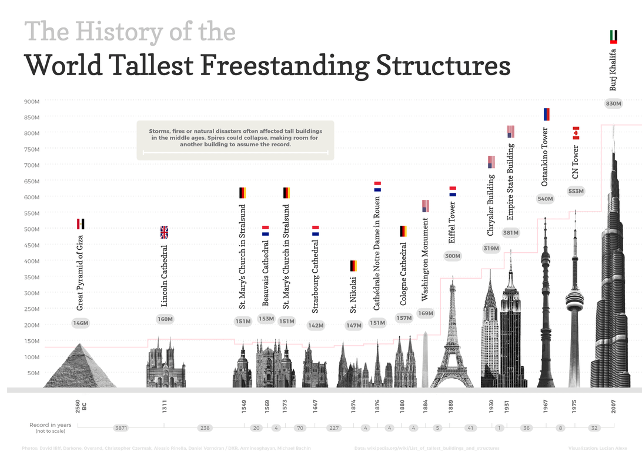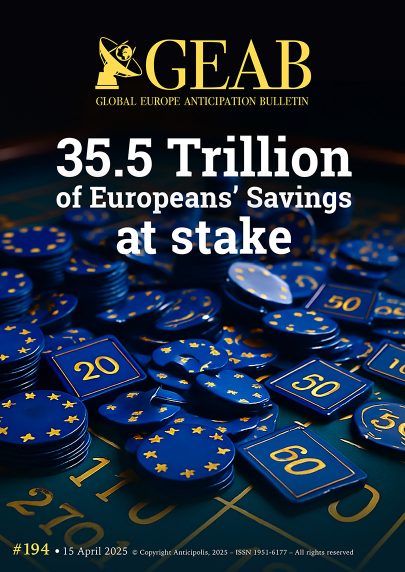GEAB 194
The dread of the climate crisis could soon be replaced by that of a “global seismic crisis”, i.e. a gradual increase in the number and severity of earthquakes. If we add to this the increase in sinkholes, it would seem that the ground is planning to give way beneath our feet more and more often… Nature’s latest thumbing of the nose at an arrogance that we have to wonder how much longer we will be able to finance.

History of the tallest free-standing structures – Source: DatalsBeautiful
Increase in “induced” earthquakes
Admittedly, the earthquake that has just struck Burma (Myanmar) is probably natural, given its proximity to the Sasaing fault and the known displacement of the Indian tectonic plate. Myanmar is exposed to a high seismic risk[1]. The same applies to Turkey, which lies on the Anatolian plate, compressed between the Eurasian and Arabian plates[2].
And yet, the increase in the number of “induced earthquakes” has been confirmed: for several decades now, earthquakes have been officially associated with human activity. Drilling, fracking, geothermal energy, dams… all these uses of nature have been implicated in various seismic events such as those in Oklahoma (USA, Richter 5.8, 2016), Strasbourg (France, Richter 3, 2020), Basel (Switzerland, Richter 3.5, 2006), Pohang (South Korea, Richter 5.4, 2017), Konya (India, Richter 6.6, 1967), Sichuan (China, Richter 7.9, 2008), etc.[3]
Login

35,500 billion euros is the total amount of European savings. It's also the level of US federal debt. In twenty years, that debt has gone from 5% to 123% of [...]
Europe has long benefited from a powerful economic engine: the household savings. Built up over decades, this financial cushion, estimated at 35.5 trillion euros (against 14 trillion public debt), has [...]
Stock markets are reeling in the wake of Donald Trump's thunderous announcements. Is the US ruled by an erratic and reckless leader? Or are we witnessing the emancipation of politics [...]
At the crossroads of a Russian past, an American present and a European future, Ukraine, which for the last 3 years has been a testing ground for the wars of [...]
After almost 20 years of anticipating the collapse of the Western-centric system, the GEAB now feels it has a duty to continue to identify the crises in the making, but [...]
As in every stock market crisis, stocks will change hands. Insofar as the crisis is largely provoked, it is likely that state structures - starting with the United States - [...]


Comments
Grok: The GEAB article raises intriguing points about a potential "global seismic crisis," but its arguments need careful scrutiny. It blends observed trends, speculative risks, and societal critiques, which I'll evaluate based on available data and reasoning. Key Points and Analysis Rise in Seismic Events: Claim: The article suggests a "gradual increase in the number and severity of earthquakes" and links it to human activity and climate change. Analysis: Global earthquake frequency for major events (magnitude 7+) hasn’t shown a clear upward trend over decades, per USGS data, with roughly 15-20 such events annually. The article’s focus on "induced earthquakes" (e.g., from fracking, dams) is valid for specific regions like Oklahoma, where quakes above magnitude 3 spiked from 25/year (1973-2008) to 1,010 in 2015 due to wastewater injection. However, these are localized and mostly low-magnitude. The claim of increasing severity lacks robust evidence, as large quakes remain within natural variability. Improved detection tech also inflates reported event counts, which the article doesn’t fully address. Human-Induced Earthquakes: Claim: Activities like fracking, drilling, and dams cause earthquakes, citing examples like Oklahoma (2016, M5.8) and Sichuan (2008, M7.9). Analysis: Induced seismicity is well-documented. The Human-Induced Earthquake Database confirms links between hydraulic fracturing, geothermal projects, and small-to-moderate quakes. For instance, Oklahoma’s spike correlates with oil and gas operations. However, attributing major events like Sichuan’s 2008 quake to human activity (Zipingpu Dam) is debated—tectonic forces on the Longmenshan fault were likely dominant. The article overgeneralizes by implying human activity is a primary driver globally, when natural tectonics still govern most significant quakes. Climate Change Connection: Claim: Melting glaciers and climate-driven changes alter crustal pressures, increasing seismic risk. Analysis: This is plausible but limited in scope. Studies (e.g., GFZ, 2024) suggest glacial isostatic rebound can trigger minor quakes in regions like Greenland or Alaska by relieving pressure on faults. Sea-level rise might also affect coastal fault systems. However, the effect is small compared to tectonic forces, and evidence for widespread climate-driven seismicity is thin. The article’s framing risks exaggerating this factor. Sinkholes and Infrastructure: Claim: Sinkholes, caused by aging infrastructure or natural processes, are a growing threat, with examples like Tokyo and Rome. Analysis: Sinkholes are a real issue, often tied to leaky pipes or urban karst geology. Japan’s 2,600 sinkholes in 2022 from old pipes and Rome’s sewage-related collapses are credible cases. The article’s cost estimates (e.g., Japan’s infrastructure maintenance rising to $8.5 billion by 2028) align with urban maintenance challenges. However, linking sinkholes to a broader "soil betrayal" or seismic crisis is speculative and conflates distinct phenomena. Societal and Economic Impacts: Claim: Rising seismic risks strain insurance, construction standards, and governance, with costs like 20% extra for anti-seismic building upgrades. Analysis: The article’s economic points are grounded. Insurance payouts (e.g., THB 1 billion in Bangkok) and rising premiums reflect growing risk awareness. Anti-seismic standards, as in Japan or Bangkok, do increase construction costs, and the 20% estimate aligns with engineering studies. However, the apocalyptic tone—suggesting societies can’t afford these adaptations—overlooks adaptive capacity in wealthier nations. Poorer countries face bigger challenges, but the article doesn’t quantify this gap. Speculative Risks: Claim: A "tipping point" could trigger a chain reaction of seismic events, exacerbated by population growth. Analysis: The idea of a seismic chain reaction is theoretically possible (e.g., stress transfer between faults), but the article provides no evidence for a global threshold. Population density does amplify quake impacts, as seen in urban disasters like Haiti (2010). However, the "tipping point" narrative feels alarmist without data on fault interactions or systemic crustal weakening. Critique of Modernity: Claim: Neglecting maintenance and over-relying on innovation signals societal decline, with seismic risks as nature’s rebuke. Analysis: This is a philosophical stance, not a scientific one. While infrastructure neglect (e.g., Brussels’ sewer issues) is a real problem, framing it as "nature’s thumbing of the nose" anthropomorphizes complex geophysical processes. The critique of debt-laden societies struggling with maintenance costs has merit but isn’t unique to seismic risks—it applies to all infrastructure challenges. Strengths of the Article Highlights real issues: Induced seismicity, sinkholes, and urban vulnerabilities are well-documented. Ties economic and governance challenges to environmental risks, which is relevant for policy. Cites specific cases (e.g., Oklahoma, Bangkok) and sources (USGS, GFZ), adding credibility. Weaknesses Overstates global seismic trends without clear evidence of increasing frequency or severity. Conflates localized induced quakes with natural tectonics, risking misinterpretation. Speculative "tipping point" and "global seismic crisis" claims lack data. Alarmist tone (e.g., "ground giving way") may exaggerate risks for dramatic effect. Mixes geophysical, infrastructural, and societal issues without clear causal links. Reasons for Perceived Rise in Seismic Events Based on the article and broader data: Natural Variability: Tectonic activity fluctuates, with clustering of events (e.g., Myanmar, Turkey) reflecting active fault zones. Human Activity: Fracking, dams, and geothermal projects cause localized quakes, especially in the U.S. and parts of Asia. Climate Influence: Minor effects from glacial melting or sea-level rise, but not a major driver. Better Detection: Seismic networks now catch smaller quakes, inflating event counts. Urban Exposure: Growing populations in quake-prone cities (e.g., Bangkok) increase impacts and awareness. Media Amplification: Social media and news, including X posts, heighten perceptions of frequency. Conclusion The article raises valid concerns about induced seismicity, infrastructure decay, and urban risks, but its "global seismic crisis" narrative overreaches. Earthquake frequency hasn’t surged globally, though human activities and better monitoring make it seem so in some areas. Sinkholes and aging pipes are serious but separate issues. The call for better standards and maintenance is sound, but the apocalyptic framing risks fearmongering. If you want, I can dig into specific regions or recent X posts for more context on seismic trends.